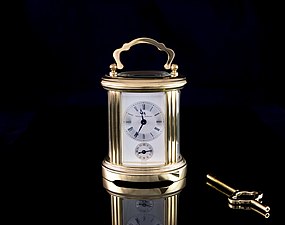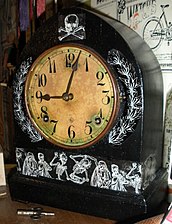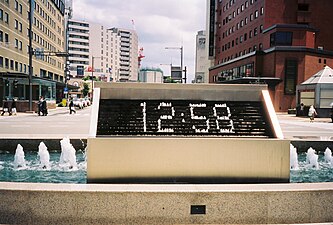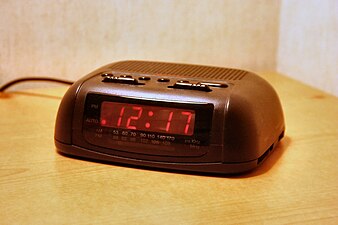Clock
A clock or chronometer is a device that measures and displays time. The clock is one of the oldest human inventions, meeting the need to measure intervals of time shorter than the natural units such as the day, the lunar month, and the year. Devices operating on several physical processes have been used over the millennia.
Some predecessors to the modern clock may be considered "clocks" that are based on movement in nature: A sundial shows the time by displaying the position of a shadow on a flat surface. There is a range of duration timers, a well-known example being the hourglass. Water clocks, along with sundials, are possibly the oldest time-measuring instruments. A major advance occurred with the invention of the verge escapement, which made possible the first mechanical clocks around 1300 in Europe, which kept time with oscillating timekeepers like balance wheels.[1][2][3][4]
Traditionally, in
The timekeeping element in every modern clock is a harmonic oscillator, a physical object (resonator) that vibrates or oscillates at a particular frequency.[2] This object can be a pendulum, a balance wheel, a tuning fork, a quartz crystal, or the vibration of electrons in atoms as they emit microwaves, the last of which is so precise that it serves as the definition of the second.
Clocks have different ways of displaying the time. Analog clocks indicate time with a traditional
Etymology
The word clock derives from the medieval Latin word for 'bell'—clocca—and has cognates in many European languages. Clocks spread to England from the Low Countries,[6] so the English word came from the Middle Low German and Middle Dutch Klocke.[7] The word derives from the Middle English clokke, Old North French cloque, or Middle Dutch clocke, all of which mean 'bell'.
History of time-measuring devices
Sundials
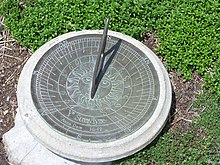
The apparent position of the Sun in the sky changes over the course of each day, reflecting the rotation of the Earth. Shadows cast by stationary objects move correspondingly, so their positions can be used to indicate the time of day. A sundial shows the time by displaying the position of a shadow on a (usually) flat surface that has markings that correspond to the hours.[8] Sundials can be horizontal, vertical, or in other orientations. Sundials were widely used in ancient times.[9] With knowledge of latitude, a well-constructed sundial can measure local solar time with reasonable accuracy, within a minute or two. Sundials continued to be used to monitor the performance of clocks until the 1830s, when the use of the telegraph and trains standardized time and time zones between cities.[10]
Devices that measure duration, elapsed time and intervals

Many devices can be used to mark the passage of time without respect to reference time (time of day, hours, minutes, etc.) and can be useful for measuring duration or intervals. Examples of such duration timers are candle clocks, incense clocks, and the hourglass. Both the candle clock and the incense clock work on the same principle, wherein the consumption of resources is more or less constant, allowing reasonably precise and repeatable estimates of time passages. In the hourglass, fine sand pouring through a tiny hole at a constant rate indicates an arbitrary, predetermined passage of time. The resource is not consumed, but re-used.
Water clocks
Water clocks, along with sundials, are possibly the oldest time-measuring instruments, with the only exception being the day-counting tally stick.[11] Given their great antiquity, where and when they first existed is not known and is perhaps unknowable. The bowl-shaped outflow is the simplest form of a water clock and is known to have existed in Babylon and Egypt around the 16th century BC. Other regions of the world, including India and China, also have early evidence of water clocks, but the earliest dates are less certain. Some authors, however, write about water clocks appearing as early as 4000 BC in these regions of the world.[12]
The
Some water clock designs were developed independently, and some knowledge was transferred through the spread of trade.
Islamic civilization is credited with further advancing the accuracy of clocks through elaborate engineering. In 797 (or possibly 801), the
Mechanical water clocks
The first known geared clock was invented by the great mathematician, physicist, and engineer Archimedes during the 3rd century BC. Archimedes created his astronomical clock,[17][citation needed] which was also a cuckoo clock with birds singing and moving every hour. It is the first carillon clock as it plays music simultaneously with a person blinking his eyes, surprised by the singing birds. The Archimedes clock works with a system of four weights, counterweights, and strings regulated by a system of floats in a water container with siphons that regulate the automatic continuation of the clock. The principles of this type of clock are described by the mathematician and physicist Hero,[18] who says that some of them work with a chain that turns a gear in the mechanism.[19] Another Greek clock probably constructed at the time of Alexander was in Gaza, as described by Procopius.[20] The Gaza clock was probably a Meteoroskopeion, i.e., a building showing celestial phenomena and the time. It had a pointer for the time and some automations similar to the Archimedes clock. There were 12 doors opening one every hour, with Hercules performing his labors, the Lion at one o'clock, etc., and at night a lamp becomes visible every hour, with 12 windows opening to show the time.
The Tang dynasty Buddhist monk Yi Xing along with government official Liang Lingzan made the escapement in 723 (or 725) to the workings of a water-powered armillary sphere and clock drive, which was the world's first clockwork escapement.[21][22] The Song dynasty polymath and genius Su Song (1020–1101) incorporated it into his monumental innovation of the astronomical clock tower of Kaifeng in 1088.[23][24][page needed] His astronomical clock and rotating armillary sphere still relied on the use of either flowing water during the spring, summer, and autumn seasons or liquid mercury during the freezing temperatures of winter (i.e., hydraulics). In Su Song's waterwheel linkwork device, the action of the escapement's arrest and release was achieved by gravity exerted periodically as the continuous flow of liquid-filled containers of a limited size. In a single line of evolution, Su Song's clock therefore united the concepts of the clepsydra and the mechanical clock into one device run by mechanics and hydraulics. In his memorial, Su Song wrote about this concept:
According to your servant's opinion there have been many systems and designs for astronomical instruments during past dynasties all differing from one another in minor respects. But the principle of the use of water-power for the driving mechanism has always been the same. The heavens move without ceasing but so also does water flow (and fall). Thus if the water is made to pour with perfect evenness, then the comparison of the rotary movements (of the heavens and the machine) will show no discrepancy or contradiction; for the unresting follows the unceasing.
Song was also strongly influenced by the earlier armillary sphere created by
In the 12th century,
Fully mechanical
This section needs additional citations for verification. (January 2024) |
The word horologia (from the Greek ὥρα—'hour', and λέγειν—'to tell') was used to describe early mechanical clocks,
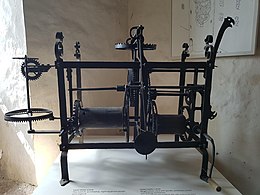
In Europe, between 1280 and 1320, there was an increase in the number of references to clocks and horologes in church records, and this probably indicates that a new type of clock mechanism had been devised. Existing clock mechanisms that used water power were being adapted to take their driving power from falling weights. This power was controlled by some form of oscillating mechanism, probably derived from existing bell-ringing or alarm devices. This controlled release of power – the escapement – marks the beginning of the true mechanical clock, which differed from the previously mentioned cogwheel clocks. The verge escapement mechanism appeared during the surge of true mechanical clock development, which did not need any kind of fluid power, like water or mercury, to work.
These mechanical clocks were intended for two main purposes: for signalling and notification (e.g., the timing of services and public events) and for modeling the solar system. The former purpose is administrative; the latter arises naturally given the scholarly interests in astronomy, science, and astrology and how these subjects integrated with the religious philosophy of the time. The astrolabe was used both by astronomers and astrologers, and it was natural to apply a clockwork drive to the rotating plate to produce a working model of the solar system.
Simple clocks intended mainly for notification were installed in towers and did not always require faces or hands. They would have announced the
In 1283, a large clock was installed at
Astronomical
An elaborate water clock, the 'Cosmic Engine', was invented by Su Song, a Chinese polymath, designed and constructed in China in 1092. This great astronomical hydromechanical clock tower was about ten metres high (about 30 feet) and was indirectly powered by a rotating wheel with falling water and liquid mercury, which turned an armillary sphere capable of calculating complex astronomical problems.
In Europe, there were the clocks constructed by
The Astrarium of Giovanni Dondi dell'Orologio was a complex astronomical clock built between 1348 and 1364 in Padua, Italy, by the doctor and clock-maker Giovanni Dondi dell'Orologio. The Astrarium had seven faces and 107 moving gears; it showed the positions of the sun, the moon and the five planets then known, as well as religious feast days. The astrarium stood about 1 metre high, and consisted of a seven-sided brass or iron framework resting on 7 decorative paw-shaped feet. The lower section provided a 24-hour dial and a large calendar drum, showing the fixed feasts of the church, the movable feasts, and the position in the zodiac of the moon's ascending node. The upper section contained 7 dials, each about 30 cm in diameter, showing the positional data for the Primum Mobile, Venus, Mercury, the moon, Saturn, Jupiter, and Mars. Directly above the 24-hour dial is the dial of the Primum Mobile, so called because it reproduces the diurnal motion of the stars and the annual motion of the sun against the background of stars. Each of the 'planetary' dials used complex clockwork to produce reasonably accurate models of the planets' motion. These agreed reasonably well both with Ptolemaic theory and with observations.[39][40]
Wallingford's clock had a large astrolabe-type dial, showing the sun, the moon's age, phase, and node, a star map, and possibly the planets. In addition, it had a wheel of fortune and an indicator of the state of the tide at London Bridge. Bells rang every hour, the number of strokes indicating the time.[37] Dondi's clock was a seven-sided construction, 1 metre high, with dials showing the time of day, including minutes, the motions of all the known planets, an automatic calendar of fixed and movable feasts, and an eclipse prediction hand rotating once every 18 years.[38] It is not known how accurate or reliable these clocks would have been. They were probably adjusted manually every day to compensate for errors caused by wear and imprecise manufacture. Water clocks are sometimes still used today, and can be examined in places such as ancient castles and museums. The Salisbury Cathedral clock, built in 1386, is considered to be the world's oldest surviving mechanical clock that strikes the hours.[41]
Spring-driven
- Examples of spring-driven clocks
-
Matthew Norman carriage clock with winding key
-
Decorated William Gilbert mantel clock
Clockmakers developed their art in various ways. Building smaller clocks was a technical challenge, as was improving accuracy and reliability. Clocks could be impressive showpieces to demonstrate skilled craftsmanship, or less expensive, mass-produced items for domestic use. The escapement in particular was an important factor affecting the clock's accuracy, so many different mechanisms were tried.
Spring-driven clocks appeared during the 15th century,[42][43][44] although they are often erroneously credited to Nuremberg watchmaker Peter Henlein (or Henle, or Hele) around 1511.[45][46][47] The earliest existing spring driven clock is the chamber clock given to Phillip the Good, Duke of Burgundy, around 1430, now in the Germanisches Nationalmuseum.[4] Spring power presented clockmakers with a new problem: how to keep the clock movement running at a constant rate as the spring ran down. This resulted in the invention of the stackfreed and the fusee in the 15th century, and many other innovations, down to the invention of the modern going barrel in 1760.
Early clock dials did not indicate minutes and seconds. A clock with a dial indicating minutes was illustrated in a 1475 manuscript by Paulus Almanus,[48] and some 15th-century clocks in Germany indicated minutes and seconds.[49] An early record of a seconds hand on a clock dates back to about 1560 on a clock now in the Fremersdorf collection.[50]: 417–418 [51]
During the 15th and 16th centuries, clockmaking flourished, particularly in the metalworking towns of Nuremberg and Augsburg, and in Blois, France. Some of the more basic table clocks have only one time-keeping hand, with the dial between the hour markers being divided into four equal parts making the clocks readable to the nearest 15 minutes. Other clocks were exhibitions of craftsmanship and skill, incorporating astronomical indicators and musical movements. The cross-beat escapement was invented in 1584 by Jost Bürgi, who also developed the remontoire. Bürgi's clocks were a great improvement in accuracy as they were correct to within a minute a day.[52][53] These clocks helped the 16th-century astronomer Tycho Brahe to observe astronomical events with much greater precision than before.[citation needed][how?]

Pendulum
The next development in accuracy occurred after 1656 with the invention of the
In 1670, William Clement created the anchor escapement,[55] an improvement over Huygens' crown escapement. Clement also introduced the pendulum suspension spring in 1671. The concentric minute hand was added to the clock by Daniel Quare, a London clockmaker and others, and the second hand was first introduced.
Hairspring
In 1675, Huygens and
Marine chronometer
A major stimulus to improving the accuracy and reliability of clocks was the importance of precise time-keeping for navigation. The position of a ship at sea could be determined with reasonable accuracy if a navigator could refer to a clock that lost or gained less than about 10 seconds per day. This clock could not contain a pendulum, which would be virtually useless on a rocking ship. In 1714, the British government offered large
In 1735, Harrison built his first chronometer, which he steadily improved on over the next thirty years before submitting it for examination. The clock had many innovations, including the use of bearings to reduce friction, weighted balances to compensate for the ship's pitch and roll in the sea and the use of two different metals to reduce the problem of expansion from heat. The chronometer was tested in 1761 by Harrison's son and by the end of 10 weeks the clock was in error by less than 5 seconds.[59]
Mass production
The British had dominated watch manufacture for much of the 17th and 18th centuries, but maintained a system of production that was geared towards high quality products for the elite.[60] Although there was an attempt to modernise clock manufacture with mass-production techniques and the application of duplicating tools and machinery by the British Watch Company in 1843, it was in the United States that this system took off. In 1816, Eli Terry and some other Connecticut clockmakers developed a way of mass-producing clocks by using interchangeable parts.[61] Aaron Lufkin Dennison started a factory in 1851 in Massachusetts that also used interchangeable parts, and by 1861 was running a successful enterprise incorporated as the Waltham Watch Company.[62][63]
Early electric
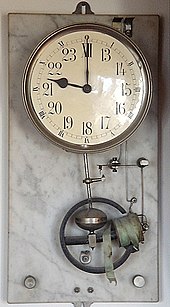
In 1815, the English scientist
Where an AC electrical supply of stable frequency is available, timekeeping can be maintained very reliably by using a synchronous motor, essentially counting the cycles. The supply current alternates with an accurate frequency of 50 hertz in many countries, and 60 hertz in others. While the frequency may vary slightly during the day as the load changes, generators are designed to maintain an accurate number of cycles over a day, so the clock may be a fraction of a second slow or fast at any time, but will be perfectly accurate over a long time. The rotor of the motor rotates at a speed that is related to the alternation frequency. Appropriate gearing converts this rotation speed to the correct ones for the hands of the analog clock. Time in these cases is measured in several ways, such as by counting the cycles of the AC supply, vibration of a tuning fork, the behaviour of quartz crystals, or the quantum vibrations of atoms. Electronic circuits divide these high-frequency oscillations to slower ones that drive the time display.
Quartz
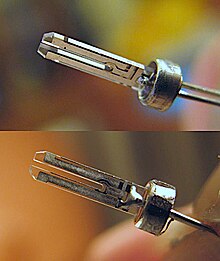
The
Atomic
Currently,
Operation
The invention of the mechanical clock in the 13th century initiated a change in timekeeping methods from continuous processes, such as the motion of the gnomon's shadow on a sundial or the flow of liquid in a water clock, to periodic oscillatory processes, such as the swing of a pendulum or the vibration of a quartz crystal,[3][79] which had the potential for more accuracy. All modern clocks use oscillation.
Although the mechanisms they use vary, all oscillating clocks, mechanical, electric, and atomic, work similarly and can be divided into analogous parts.
Power source
- In mechanical clocks, the power source is typically either a weight suspended from a cord or chain wrapped around a pulley, sprocket or drum; or a spiral spring called a mainspring. Mechanical clocks must be wound periodically, usually by turning a knob or key or by pulling on the free end of the chain, to store energy in the weight or spring to keep the clock running.
- In AC power line. In clocks that use AC power, a small backup battery is often included to keep the clock running if it is unplugged temporarily from the wall or during a power outage. Battery-powered analog wall clocks are available that operate over 15 years between battery changes.
Oscillator
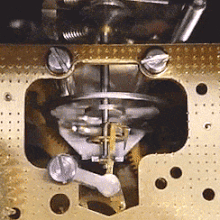
The timekeeping element in every modern clock is a harmonic oscillator, a physical object (resonator) that vibrates or oscillates repetitively at a precisely constant frequency.[2][83][84][85]
- In mechanical clocks, this is either a pendulum or a balance wheel.
- In some early electronic clocks and watches such as the Accutron, it is a tuning fork.
- In quartz clocks and watches, it is a quartz crystal.
- In atomic clocks, it is the vibration of electrons in atoms as they emit microwaves.
- In early mechanical clocks before 1657, it was a crude balance wheel or foliot which was not a harmonic oscillator because it lacked a balance spring. As a result, they were very inaccurate, with errors of perhaps an hour a day.[86]
The advantage of a harmonic oscillator over other forms of oscillator is that it employs
Synchronized or slave clocks
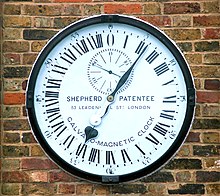
Some clocks rely for their accuracy on an external oscillator; that is, they are automatically synchronized to a more accurate clock:
- Slave clocks, used in large institutions and schools from the 1860s to the 1970s, kept time with a pendulum, but were wired to a master clock in the building, and periodically received a signal to synchronize them with the master, often on the hour.[90] Later versions without pendulums were triggered by a pulse from the master clock and certain sequences used to force rapid synchronization following a power failure.
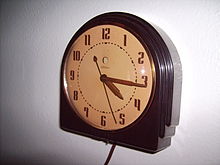
- Synchronous electric clocks do not have an internal oscillator, but count cycles of the 50 or 60 Hz oscillation of the AC power line, which is synchronized by the utility to a precision oscillator. The counting may be done electronically, usually in clocks with digital displays, or, in analog clocks, the AC may drive a synchronous motor which rotates an exact fraction of a revolution for every cycle of the line voltage, and drives the gear train. Although changes in the grid line frequency due to load variations may cause the clock to temporarily gain or lose several seconds during the course of a day, the total number of cycles per 24 hours is maintained extremely accurately by the utility company, so that the clock keeps time accurately over long periods.
- Computer real-time clocks keep time with a quartz crystal, but can be periodically (usually weekly) synchronized over the Internet to atomic clocks (UTC), using the Network Time Protocol (NTP).
- time signals transmitted from dedicated standard time radio stations or satellite navigationsignals, which are set by atomic clocks.
Controller
This has the dual function of keeping the oscillator running by giving it 'pushes' to replace the energy lost to friction, and converting its vibrations into a series of pulses that serve to measure the time.
- In mechanical clocks, this is the escapement, which gives precise pushes to the swinging pendulum or balance wheel, and releases one gear tooth of the escape wheel at each swing, allowing all the clock's wheels to move forward a fixed amount with each swing.
- In electronic clocks this is an electronic oscillator circuit that gives the vibrating quartz crystal or tuning fork tiny 'pushes', and generates a series of electrical pulses, one for each vibration of the crystal, which is called the clock signal.
- In atomic clocks the controller is an evacuated microwave digital counters to become the clock signal.[91]
In mechanical clocks, the low Q of the balance wheel or pendulum oscillator made them very sensitive to the disturbing effect of the impulses of the escapement, so the escapement had a great effect on the accuracy of the clock, and many escapement designs were tried. The higher Q of resonators in electronic clocks makes them relatively insensitive to the disturbing effects of the drive power, so the driving oscillator circuit is a much less critical component.[2]
Counter chain
This counts the pulses and adds them up to get traditional time units of seconds, minutes, hours, etc. It usually has a provision for setting the clock by manually entering the correct time into the counter.
- In mechanical clocks this is done mechanically by a wheel train. The gear train also has a second function; to transmit mechanical power from the power source to run the oscillator. There is a friction coupling called the 'cannon pinion' between the gears driving the hands and the rest of the clock, allowing the hands to be turned to set the time.[92]
- In digital clocks a series of binarylogic. Often pushbuttons on the case allow the hour and minute counters to be incremented and decremented to set the time.
Indicator
This displays the count of seconds, minutes, hours, etc. in a human readable form.
- The earliest mechanical clocks in the 13th century did not have a visual indicator and signalled the time audibly by striking bells. Many clocks to this day are striking clocks which strike the hour.
- Analog clocks display time with an analog hour hand, which makes one or two revolutions in a day, while the minutes are indicated by a minute hand, which makes one revolution per hour. In mechanical clocks a gear train drives the hands; in electronic clocks the circuit produces pulses every second which drive a stepper motorand gear train, which move the hands.
- Digital clocks display the time in periodically changing digits on a digital display. A common misconception is that a digital clock is more accurate than an analog wall clock, but the indicator type is separate and apart from the accuracy of the timing source.
- synthesized voices.
Types
Clocks can be classified by the type of time display, as well as by the method of timekeeping.
Time display methods
Analog
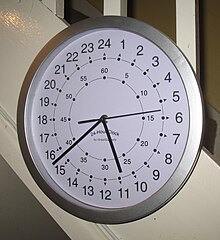
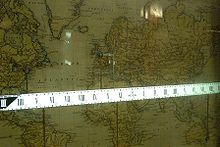
Analog clocks usually use a
Another type of analog clock is the sundial, which tracks the sun continuously, registering the time by the shadow position of its
Digital
- Examples of digital clocks
-
Digital clock displaying time by controlling valves on the fountain
-
Simplistic digital clock radio
-
Diagram of a mechanical digital display of a flip clock
-
A digital clock on a Samsung Galaxy smartphone
Digital clocks display a numeric representation of time. Two numeric display formats are commonly used on digital clocks:
- the 24-hour notationwith hours ranging 00–23;
- the 12-hour notationwith AM/PM indicator, with hours indicated as 12AM, followed by 1AM–11AM, followed by 12PM, followed by 1PM–11PM (a notation mostly used in domestic environments).
Most digital clocks use electronic mechanisms and
Some clocks, called 'flip clocks', have digital displays that work mechanically. The digits are painted on sheets of material which are mounted like the pages of a book. Once a minute, a page is turned over to reveal the next digit. These displays are usually easier to read in brightly lit conditions than LCDs or LEDs. Also, they do not go back to 12:00 after a power interruption. Flip clocks generally do not have electronic mechanisms. Usually, they are driven by AC-synchronous motors.
Hybrid (analog-digital)
Clocks with analog quadrants, with a digital component, usually minutes and hours displayed analogously and seconds displayed in digital mode.
Auditory
For convenience, distance, telephony or blindness, auditory clocks present the time as sounds. The sound is either spoken natural language, (e.g. "The time is twelve thirty-five"), or as auditory codes (e.g. number of sequential bell rings on the hour represents the number of the hour like the bell, Big Ben). Most telecommunication companies also provide a speaking clock service as well.
Word

Word clocks are clocks that display the time visually using sentences. E.g.: "It's about three o'clock." These clocks can be implemented in hardware or software.
Projection
Some clocks, usually digital ones, include an optical
Tactile
Auditory and projection clocks can be used by people who are blind or have limited vision. There are also clocks for the blind that have displays that can be read by using the sense of touch. Some of these are similar to normal analog displays, but are constructed so the hands can be felt without damaging them. Another type is essentially digital, and uses devices that use a code such as Braille to show the digits so that they can be felt with the fingertips.
Multi-display
Some clocks have several displays driven by a single mechanism, and some others have several completely separate mechanisms in a single case. Clocks in public places often have several faces visible from different directions, so that the clock can be read from anywhere in the vicinity; all the faces show the same time. Other clocks show the current time in several time-zones. Watches that are intended to be carried by travellers often have two displays, one for the local time and the other for the time at home, which is useful for making pre-arranged phone calls. Some equation clocks have two displays, one showing mean time and the other solar time, as would be shown by a sundial. Some clocks have both analog and digital displays. Clocks with Braille displays usually also have conventional digits so they can be read by sighted people.
Purposes

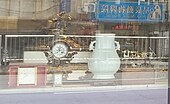
Clocks are in homes, offices and many other places; smaller ones (watches) are carried on the wrist or in a pocket; larger ones are in public places, e.g. a railway station or church. A small clock is often shown in a corner of computer displays, mobile phones and many
The primary purpose of a clock is to display the time. Clocks may also have the facility to make a loud alert signal at a specified time, typically to waken a sleeper at a preset time; they are referred to as alarm clocks. The alarm may start at a low volume and become louder, or have the facility to be switched off for a few minutes then resume. Alarm clocks with visible indicators are sometimes used to indicate to children too young to read the time that the time for sleep has finished; they are sometimes called training clocks.
A clock mechanism may be used to control a device according to time, e.g. a central heating system, a
Most
In Chinese culture,
Time standards
For some scientific work timing of the utmost accuracy is essential. It is also necessary to have a standard of the maximum accuracy against which working clocks can be calibrated. An ideal clock would give the time to unlimited accuracy, but this is not realisable. Many physical processes, in particular including some
Until advances in the late twentieth century, navigation depended on the ability to measure
Sports and games
Clocks can be used to measure varying periods of time in games and sports.
Specific types

Awards
- Grand Prix d'Horlogerie de Genève [de] (GPHG)
- Goldene Unruh [de]
See also
- 24-hour analog dial
- Allan variance
- Allen-Bradley Clock Tower at Rockwell Automation Headquarters Building (Wisconsin)
- American Watchmakers-Clockmakers Institute
- BaselWorld
- Biological clock
- Castle clock
- Clockarium
- Clock as herald of the Industrial Revolution (Lewis Mumford)
- Clock face
- Clock drift
- Clock ident
- Clock network
- Clock of the Long Now
- Clock signal (digital circuits)
- Clockkeeper
- Clockmaker
- Colgate Clock (Indiana)
- Colgate Clock (New Jersey), largest clock in US
- Corpus Clock
- Cosmo Clock 21, world's largest clock
- Cox's timepiece
- Cuckooland Museum
- Date and time representation by country
- Debt clock
- Le Défenseur du Temps (automata)
- Department of Defense master clock (U.S.)
- Doomsday Clock
- Earth clock
- Equation clock
- Federation of the Swiss Watch Industry FH
- Guard tour patrol system (watchclocks)
- Iron Ring Clock
- Jens Olsen's World Clock
- Jewel bearing
- List of biggest clock faces
- List of clocks
- List of international common standards
- List of largest cuckoo clocks
- Metrology
- Mora clock
- National Association of Watch and Clock Collectors
- Projection clock
- Replica watch
- Rubik's Clock
- Star clock
- Singing bird box
- System time
- Time to digital converter
- Timeline of time measurement technology
- Timer
- Watch
- Watchmaker
Notes and references
- ISBN 978-0-226-15511-1. Archivedfrom the original on July 3, 2023. Retrieved October 30, 2020., pp. 103–104.
- ^ doi:10.1002/j.1538-7305.1948.tb01343.x. Archived from the original(PDF) on November 10, 2014. Retrieved November 10, 2014.
- ^ ISBN 978-0-393-32443-3. Archivedfrom the original on July 3, 2023. Retrieved October 30, 2020., p. 31.
- ^ a b White, Lynn Jr. (1962). Medieval Technology and Social Change. UK: Oxford Univ. Press. p. 119.
- ^ "Cambridge Advanced Learner's Dictionary". Archived from the original on March 7, 2023. Retrieved January 29, 2018.
a device for measuring and showing time, which is usually found in or on a building and is not worn by a person
- ^ Wedgwood, Hensleigh (1859). A Dictionary of English Etymology: A – D, Vol. 1. London: Trübner and Co. p. 354. Archived from the original on July 3, 2023. Retrieved October 30, 2020.
- ISBN 978-0-19-960111-0. Archivedfrom the original on July 3, 2023. Retrieved October 30, 2020.
- ^ "How Sundials Work". The British Sundial Society. November 7, 2013. Archived from the original on November 10, 2014. Retrieved November 10, 2014.
- ^ "Ancient Sundials". North American Sundial Society. Archived from the original on November 10, 2014. Retrieved November 10, 2014.
- ISBN 978-0-8153-0322-0.
- ^ Turner 1984, p. 1
- ^ Cowan 1958, p. 58
- ^ "Tower of the Winds – Athens". sailingissues.com. Archived from the original on December 9, 2008. Retrieved November 4, 2008.
- ^ "Water Clock | China | Western Han dynasty (206 BCE–9 CE)". The Metropolitan Museum of Art. Archived from the original on April 5, 2023.
- ISBN 978-0-345-40102-1.
- ^ William Godwin (1876). Lives of the Necromancers. London, F.J. Mason. p. 232.
- ISBN 978-618-83695-0-4.
- ^ Dasypodius, K. (1580). Heron mechanicus.
- ^ Hero, of Alexandria. see Hero's books: Pneumatica (Πνευματικά), Automata, Mechanica, Metrica, Dioptra. Alexandria.
- ^ Procopius of Caesarea, Προκόπιος ὁ Καισαρεύς (c. 500s). Περὶ Κτισμάτων, Perì Ktismáton; Latin: De Aedificiis, On Buildings.
- ^ Needham, Joseph (1986). Science and Civilization in China: Volume 4, Physics and Physical Technology, Part 2, Mechanical Engineering. Taipei: Caves Books Ltd, p. 165.
- ^ Needham, Joseph (1986). Science and Civilization in China: Volume 4, Physics and Physical Technology, Part 2, Mechanical Engineering. Taipei: Caves Books Ltd, p. 319.
- ^ "No. 120: Su-Sung's Clock". www.uh.edu. Archived from the original on February 26, 2021. Retrieved February 18, 2021.
- ^ History of Song 宋史, Vol. 340
- ^ "Past Masters: The Astronomical Water Clock Of Su Song". revolutionwatch.com. August 8, 2014. Archived from the original on April 7, 2022. Retrieved June 4, 2022.
- ^ Derek J. de Solla Price, On the Origin of Clockwork, Perpetual Motion Devices, and the Compass, p.86
- Donald Routledge Hill, Dordrecht/D. Reidel.
- ^ "Remaking History: Ismail al-Jazari and the Elephant Water Clock - Make". Make: DIY Projects and Ideas for Makers. May 7, 2021. Archived from the original on January 11, 2023. Retrieved January 11, 2023.
- , History of Science and Technology in Islam
- ISBN 0-911119-43-4.
- ^ Leonhard Schmitz; Smith, William (1875). A Dictionary of Greek and Roman Antiquities. London: John Murray. pp. 615‑617. Archived from the original on July 3, 2023. Retrieved February 19, 2021.
- ^ Modern French horloge is very close; Spanish reloj and Portuguese relógio drop the first part of the word.
- ^ Bulletin de la société archéologique de Sens, year 1867, vol. IX, p. 390, available at www.archive.org.
- ^ See also fr:Discussion:Horloge[circular reference]
- ^ The Chronicle of Jocelin of Brakelond, Monk of St. Edmundsbury: A Picture of Monastic and Social Life on the XIIth Century. London: Chatto and Windus. Translated and edited by L.C. Jane. 1910.
- ^ a b "Clocks – Crystalinks". www.crystalinks.com. Archived from the original on June 6, 2019. Retrieved June 6, 2019.
- ^ a b North, John. God's Clockmaker: Richard of Wallingford and the Invention of Time. London: Hambledon and London (2005).
- ^ a b c King, Henry "Geared to the Stars: the evolution of planetariums, orreries, and astronomical clocks", University of Toronto Press, 1978
- ^ "Giovanni Dondi's Astrarium, 1364 | cabinet". www.cabinet.ox.ac.uk. Archived from the original on November 20, 2021. Retrieved June 5, 2022.
- from the original on June 4, 2022. Retrieved June 5, 2022.
- ^ Singer, Charles, et al. Oxford History of Technology: volume II, from the Renaissance to the Industrial Revolution (OUP 1957) pp. 650–651
- ISBN 978-0-19-500266-9.
- ISBN 978-0-486-25593-4. Archivedfrom the original on July 3, 2023. Retrieved June 5, 2020.
- ISBN 978-0-226-15510-4. Archivedfrom the original on July 3, 2023. Retrieved June 5, 2020.
- ISBN 978-0-7808-0008-3.
- ISBN 978-0-85229-290-7.
- ISBN 978-0-8242-0958-2.
- ISBN 0-8153-0322-X.
- ISBN 978-0-486-25593-4. Archivedfrom the original on July 3, 2023. Retrieved October 30, 2020.
- ISBN 978-0-674-76802-4.
- ISBN 978-0-8037-4475-2. full page color photo: 4th caption page, 3rd photo thereafter (neither pages nor photos are numbered).
- ISBN 978-0-415-06042-4. Archivedfrom the original on July 3, 2023. Retrieved October 30, 2020.
- The British Museum, archivedfrom the original on November 6, 2015, retrieved April 11, 2010
- ^ "History of Clocks". Archived from the original on December 10, 2013. Retrieved December 6, 2013.
- ^ "The History of Mechanical Pendulum Clocks and Quartz Clocks". about.com. 2012. Archived from the original on May 28, 2020. Retrieved June 16, 2012.
- ^ "History Of Clocks". Archived from the original on December 10, 2013. Retrieved December 6, 2013.
- ^ Horological Journal, September 2011, pp. 408–412.
- ISBN 978-0-674-01252-3.
- ISBN 978-0-907462-05-7.
- ISBN 978-1-57230-589-2. Archivedfrom the original on July 3, 2023. Retrieved February 7, 2013.
- ^ "Eli Terry Mass-Produced Box Clock." Smithsonian The National Museum of American History. Web. 21 Sep. 2015.
- ISBN 978-0-917914-73-7).
- ISBN 978-0-8018-9141-0.
- ISBN 978-1-78326-917-4.
- ^ a b "A Revolution in Timekeeping". NIST. Archived from the original on April 9, 2008. Retrieved April 30, 2008.
- ^ "Pierre Curie". American Institute of Physics. Archived from the original on February 16, 2015. Retrieved April 8, 2008.
- S2CID 51664900.
- ^ Sullivan, D.B. (2001). "Time and frequency measurement at NIST: The first 100 years" (PDF). Time and Frequency Division, National Institute of Standards and Technology. p. 5. Archived from the original (PDF) on September 27, 2011.
- ^ "Electronic Quartz Wristwatch, 1969". IEEE History Center. Archived from the original on January 22, 2016. Retrieved July 11, 2015.
- ISBN 978-0-521-81599-4. Archivedfrom the original on July 3, 2023. Retrieved June 5, 2020.
- ^ a b Ost, Laura (August 22, 2013). "NIST Ytterbium Atomic Clocks Set Record for Stability". NIST. Archived from the original on August 23, 2013. Retrieved June 30, 2016.
- ^ Sir William Thomson (Lord Kelvin) and Peter Guthrie Tait, Treatise on Natural Philosophy, 2nd ed. (Cambridge, England: Cambridge University Press, 1879), vol. 1, part 1, p. 227 Archived April 4, 2023, at the Wayback Machine.
- ^ M.A. Lombardi; T.P. Heavner; S.R. Jefferts (2007). "NIST Primary Frequency Standards and the Realization of the SI Second" (PDF). Journal of Measurement Science. 2 (4): 74. Archived (PDF) from the original on April 24, 2008.
- ^ Sullivan, D.B. (2001). Time and frequency measurement at NIST: The first 100 years (PDF). 2001 IEEE International Frequency Control Symposium. NIST. pp. 4–17. Archived from the original (PDF) on September 27, 2011.
- ^ "Time and Frequency Division". National Institute of Standards and Technology. Archived from the original on April 15, 2008. Retrieved April 1, 2008.
- ^ "The "Atomic Age" of Time Standards". National Institute of Standards and Technology. Archived from the original on April 12, 2008. Retrieved May 2, 2008.
- ^
S2CID 4191481.
- ^ W. Markowitz; R.G. Hall; L. Essen; J.V.L. Parry (1958). "Frequency of cesium in terms of ephemeris time". .
- . Retrieved February 25, 2017.
- ISBN 978-0-486-40913-9. Archivedfrom the original on July 3, 2023. Retrieved October 30, 2020.
- ^ "How clocks work". InDepthInfo. W. J. Rayment. 2007. Archived from the original on May 15, 2008. Retrieved June 4, 2008.
- ISBN 978-0-7808-0008-3.
- ISBN 978-1-4214-3827-6.
- ^ "Mechanics: Simple harmonic oscillations". Encyclopedia Britannica online. 2020. Retrieved January 4, 2023.
- ISBN 978-0-470-17066-3. Archivedfrom the original on April 4, 2023. Retrieved March 19, 2023.
- ^ Milham, 1945, p. 85
- ^ "Quality factor, Q". Glossary. Time and Frequency Division, NIST (National Institute of Standards and Technology). 2008. Archived from the original on May 4, 2008. Retrieved June 4, 2008.
- ISBN 978-0-486-40913-9. Archivedfrom the original on July 3, 2023. Retrieved November 6, 2015.
- ]
- ^ Milham, 1945, pp. 325–328
- ISBN 978-0-486-40913-9. Archivedfrom the original on July 3, 2023. Retrieved November 6, 2015.
- ^ Milham, 1945, p. 113
- ^ U.S. patent 7,079,452, U.S. patent 7,221,624
- ISBN 978-1-119-50870-0.
- ^ Brown, Ju (2006). China, Japan, Korea Culture and Customs. p. 57.
- ^ Seligman, Scott D. (1999). Chinese business etiquette:: a guide to protocol, manners, and culture in the People's Republic of China. Hachette Digital, Inc.
- ^ http://www.sohu.com/a/160882715_578225 Archived January 5, 2018, at the Wayback Machine 别人过节喜庆的时候, 不送钟表.送终和送钟谐音.
- ^ Rizzo, John (September 10, 2023). "NFL Clock Stop Rules: A Comprehensive Guide". Metro League. Retrieved September 11, 2023.
- ^ "sports and games > sports facilities > scoreboard image - Visual Dictionary". www.ikonet.com. Retrieved September 11, 2023.
Bibliography
- Baillie, G.H., O. Clutton, & C.A. Ilbert. Britten's Old Clocks and Watches and Their Makers (7th ed.). Bonanza Books (1956).
- Bolter, David J. Turing's Man: Western Culture in the Computer Age. The University of North Carolina Press, Chapel Hill, NC (1984). ISBN 0-8078-4108-0pbk. Summary of the role of "the clock" in its setting the direction of philosophic movement for the "Western World". Cf. picture on p. 25 showing the verge and foliot. Bolton derived the picture from Macey, p. 20.
- Bruton, Eric (1982). The History of Clocks and Watches. New York: Crescent Books Distributed by Crown. ISBN 978-0-517-37744-4.
- Cowan, Harrison J. (1958). Time and Its Measurement: From the stone age to the nuclear age. Ohio: The World Publishing Company. Bibcode:1958tmfs.book.....C.
- Dohrn-van Rossum, Gerhard (1996). History of the Hour: Clocks and Modern Temporal Orders. Trans. Thomas Dunlap. Chicago: The University of Chicago Press. ISBN 978-0-226-15510-4.
- Edey, Winthrop. French Clocks. New York: Walker & Co. (1967).
- Kak, Subhash, Babylonian and Indian Astronomy: Early Connections. 2003.
- Kumar, Narendra "Science in Ancient India" (2004). ISBN 81-261-2056-8.
- Landes, David S. Revolution in Time: Clocks and the Making of the Modern World. Cambridge: Harvard University Press (1983).
- Landes, David S. Clocks & the Wealth of Nations, Daedalus Journal, Spring 2003.
- Lloyd, Alan H. "Mechanical Timekeepers", A History of Technology, Vol. III. Edited by Charles Joseph Singer et al. Oxford: Clarendon Press (1957), pp. 648–675.
- Macey, Samuel L., Clocks and the Cosmos: Time in Western Life and Thought, Archon Books, Hamden, Conn. (1980).
- ISBN 978-0-521-05803-2.
- North, John. God's Clockmaker: Richard of Wallingford and the Invention of Time. London: Hambledon and London (2005).
- Palmer, Brooks. The Book of American Clocks, The Macmillan Co. (1979).
- Robinson, Tom. The Longcase Clock. Suffolk, England: Antique Collector's Club (1981).
- Smith, Alan. The International Dictionary of Clocks. London: Chancellor Press (1996).
- Tardy. French Clocks the World Over. Part I and II. Translated with the assistance of Alexander Ballantyne. Paris: Tardy (1981).
- Turner, Anthony J. (1984). The Time Museum. Vol. I: Time Measuring Instruments. Rockford, IL: The Museum. OCLC 159866762.
- Yoder, Joella Gerstmeyer. Unrolling Time: Christiaan Huygens and the Mathematization of Nature. New York: Cambridge University Press (1988).
- Zea, Philip, & Robert Cheney. Clock Making in New England: 1725–1825. Old Sturbridge Village (1992).
External links
 Media related to Clocks at Wikimedia Commons
Media related to Clocks at Wikimedia Commons The dictionary definition of clock at Wiktionary
The dictionary definition of clock at Wiktionary- National Association of Watch & Clock Collectors Museum
- . Encyclopædia Britannica. Vol. VI (9th ed.). 1878. pp. 13–35.
- . Encyclopædia Britannica. Vol. 6 (11th ed.). 1911. pp. 536–553.



